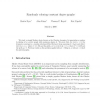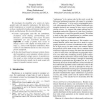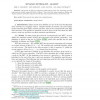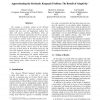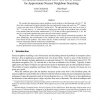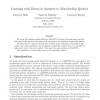99
Voted
FOCS
2004
IEEE
15 years 4 months ago
2004
IEEE
We study a simple Markov chain, known as the Glauber dynamics, for generating a random k-coloring of a n-vertex graph with maximum degree . We prove that, for every > 0, the d...
FOCS
2004
IEEE
15 years 4 months ago
2004
IEEE
We investigate the feasibility of a variety of cryptographic tasks with imperfect randomness. The kind of imperfect randomness we consider are entropy sources, such as those consi...
109
Voted
FOCS
2004
IEEE
15 years 4 months ago
2004
IEEE
In this work we look back into the proof of the PCP Theorem, with the goal of finding new proofs that are "more combinatorial" and arguably simpler. For that we introduc...
97
Voted
FOCS
2004
IEEE
15 years 4 months ago
2004
IEEE
We present an O(lg lg n)-competitive online binary search tree, improving upon the best previous (trivial) competitive ratio of O(lg n). This is the first major progress on Sleator...
113
click to vote
FOCS
2004
IEEE
15 years 4 months ago
2004
IEEE
We consider a stochastic variant of the NP-hard 0/1 knapsack problem in which item values are deterministic and item sizes are independent random variables with known, arbitrary d...
FOCS
2004
IEEE
15 years 4 months ago
2004
IEEE
The Metric Labeling problem is an elegant and powerful mathematical model capturing a wide range of classification problems. The input to the problem consists of a set of labels a...
FOCS
2004
IEEE
15 years 4 months ago
2004
IEEE
106
click to vote
FOCS
2004
IEEE
15 years 4 months ago
2004
IEEE
We consider the approximate nearest neighbour search problem on the Hamming cube {0, 1}d. We show that a randomised cell probe algorithm that uses polynomial storage and word size...
138
click to vote
FOCS
2004
IEEE
15 years 4 months ago
2004
IEEE
We study the maximum edge-disjoint paths problem in undirected planar graphs: given a graph G and node pairs (demands) s1t1, s2t2, . . ., sktk, the goal is to maximize the number ...
FOCS
2004
IEEE
15 years 4 months ago
2004
IEEE
We study the learning models defined in [AKST97]: Learning with equivalence and limited membership queries and learning with equivalence and malicious membership queries. We show ...
